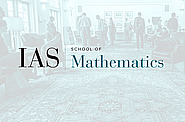2007-2008 seminars
Jun
10
2008
Computer Science/Discrete Mathematics Seminar II
Computability and Complexity of Julia sets
10:30am|S-101
May
27
2008
Computer Science/Discrete Mathematics Seminar II
Approximating Functions in Logarithmic Space and Time: A "Plug & Play" Approach
10:30am|S-101
May
26
2008
Computer Science/Discrete Mathematics Seminar I
Institute Closed in Observance of Memorial Day
11:15am
May
23
2008
May
20
2008
May
16
2008
Computer Science/Discrete Mathematics Seminar III
Reconstruction of Depth-3 Arithmetic Circuits
Amir Shpilka
10:30am|West Bldg. Lecture Hall
May
13
2008
Computer Science/Discrete Mathematics Seminar II
A Dirac-Type Theorem for 3-Uniform Hypergraphs
10:30am|West Bldg. Lecture Hall
May
12
2008
Computer Science/Discrete Mathematics Seminar I
Artin Map, Cyclotomic Function Fields, and Folded List-Decodable Codes
11:15am|West Bldg. Lecture Hall
